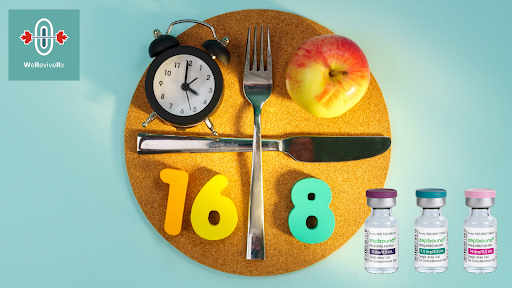Zepbound and Intermittent Fasting: Can You Do Both Together?
Zepbound and Intermittent Fasting: Can You Do Both Together?

Introduction
Intermittent fasting (IF) is one of the most popular weight loss strategies today—and now that Zepbound is gaining traction as a highly effective medication for fat loss, many are wondering: Can I combine Zepbound with intermittent fasting?
The short answer: Yes, and in many cases, the two can complement each other. But there are also things to watch out for—like low blood sugar or nausea during fasting windows.
In this post, we’ll break down how Zepbound and intermittent fasting work together, what the research says, and how to do it safely.
What Is Intermittent Fasting?
Intermittent fasting is an eating pattern—not a diet—that cycles between periods of eating and fasting. Popular methods include:
- 16:8 – Fast for 16 hours, eat within an 8-hour window
- 18:6 or 20:4 – More aggressive fasting protocols
- OMAD – “One Meal a Day”
- 5:2 – Eat normally for 5 days, restrict calories for 2 days

- Insulin sensitivity
- Blood sugar control
- Fat oxidation
- Cellular repair (autophagy)
How Zepbound Works
Zepbound (tirzepatide) mimics two gut hormones:
- GLP-1 – Suppresses appetite, slows gastric emptying, regulates blood sugar
- GIP – Enhances insulin release, improves fat metabolism
The result:




Benefits of Combining Zepbound with Fasting

Zepbound suppresses hunger naturally, making it easier to stick to fasting windows.

Both tools promote lipolysis (fat breakdown). Together, they may accelerate results—especially belly fat.

Fewer insulin spikes = improved insulin sensitivity and faster metabolic repair.

Fasting encourages discipline. Zepbound reduces emotional eating.
Things to Watch Out For

Zepbound can cause mild GI side effects. Fasting on top of that—especially in the first few weeks—can worsen symptoms.

If you’re taking Zepbound and fasting too aggressively, blood sugar may dip too low—especially if you’re also on diabetes meds.

Very long fasts (e.g. OMAD) paired with rapid weight loss may increase the chance of losing lean muscle if not monitored properly.

Tips for Doing It Safely
Start slow – Begin with a 12:12 or 14:10 schedule and build from there
Hydrate – Drink plenty of water during fasts to avoid fatigue
Break fast gently – Avoid heavy meals that may trigger nausea
Listen to your body – If Zepbound + fasting feels too intense, scale back
Strength train – To maintain muscle while losing fat
What the Research Says
While there are no large clinical trials combining Zepbound and intermittent fasting yet, evidence supports both methods individually for:
- Improving A1C
- Reducing body fat
- Lowering inflammation
- Reversing insulin resistance

Final Thoughts
Yes—you can combine Zepbound with intermittent fasting, and for many people, it creates a powerful fat-loss synergy. But it’s important to listen to your body, stay hydrated, and avoid over-restriction.




